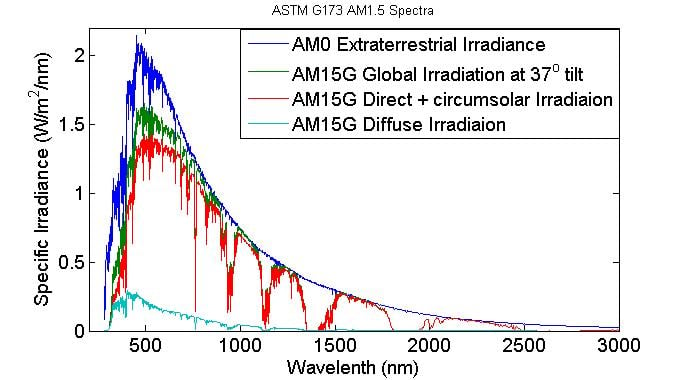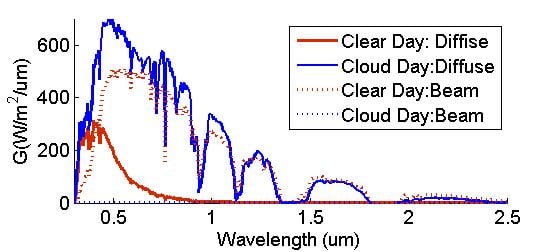Overview and Scope
The Goal for this Open Source Solar Spectrum Analyzer was to create a standalone system which when fitted with a Spectrometer, would allow for the Sun to be actively tracked and followed across the sky allowing for its Direct and Diffuse radiation to be measured . These measurements occur every hour and have enough resolution to span the UV-VIS to NIR spectrum.
In order to accomplish this, Queen's University joined up with the La Universidad Privada Boliviana in Cochabamba, Bolivia. This partnership allowed for, in addition to the different location, an insight into how International Collaboration can be implemented as well as ways to increase its productivity and efficiency.
Our systems would be designed to be as similar as possible with an exception for there individual spectrometers. This will allow us to get comparable data from both sites in order to compare the Suns radiation.
This page describes how to build an automated spectrometer for recording solar spectra. It includes links to CAD files, design, software etc. It list all the components with links to purchase locations, includes calibration protocols, etc. Everything that is needed to replicate the two examples at UPB and in Canada....and a link to the data streams.
Solar Theory
The attenuation and transmission of light in the earth's atmosphere is important in many feilds including: photovoltaics, agriculture, weather prediction and climate research. Due to the non-homegeneity of the earth's atmosphere and constantly changing solar geometry, the solar resource is variable and can have very different effects at geographically disparate sites on the planet.
Solar irradiation is composed of a spectrum of light, which can broadly be divided into UV, Visible, and Near Infared (NIR) light. The light present at the edge of the earth's atmosphere, at what is called a 0 Air Mass (AM0) is defined as the extraterrestrial insolation (Go), which is a consistently varying quantitiy, but generally defined as 1366.1 W/m^2 for engineering applications [1]. As the extraterrestrial spectrum travels throught eh earths atmosphere, it is attenuated by a vareity of atmospheric constituents, including in decending order of their relative effects on solar transmission for a clear (cloudless) sky: Aerosols (mie scattering), Particulates (Rayleigh Scattering), Water Vapour, Ozone, Carbon Dioxide, and Oxygen.
The level of the attenuation due to these atmospheric components is dependant on their relative concentrations and on the optical path length through which the solar irradiaion passes. If the sun is directly overhead, the optical path length is said to be one air mass (AM1) as the solar elevation above the horizon decreases, the sun's irradiance must pass through a larger distance before reaching the surface, and therefore the air mass will increase. For many solar photovoltaic applications, the airmass of 1.5 (AM1.5) with an associated irradiance of 1000 W/m^2 (1 sun) is consitered to be a standard atmospheric condition. A summary of the atmospheric consitituents which can afford this condiiton and for a definition of the standard AM1.5 atmosphere (ASTM G-173), a comprehensive description can be found here. For an overview of the theory of solar resource measurements, see the related page on Solar_resource_measurement_for_PV_applications. For a more in-depth overview of solar geometry, see the related page on The_Solar_Resource
The spectral distribution of irradiance from the AM1.5 spectrum is shown below.

Solar attenuation
The attenuation of the solar resource in the atmosphere effects both the integrated (broadband) value of irradiaion, as well as its distribution within the spectrum. Generally, an increase in Air Mass will tend to shift the spectrum towards "red" (Infared), as can be observed due to the red sky at morning and evening. An increase in cloud cover will tend to shift the spectrum towards the "blue" (Ultraviolet), an effect which might be noticed when receiving a sunburn on a cloudy day. As can be seen in the above figure, the attenuation of irradiaion also depends on the source of the irradiaion. Direct&circumsolar refers to that irradiation which is not scattered in the atmosphere, and is specular in nature, meaning that it is directional and will form shadows when blocked. The Diffuse irradiation is irradiaion which comes from the sky dome, and can be though of as isotropic (emminating equally from all parts of the sky dome), however for advanced irradiaion modelling, this assumption is not valid. It can be thought of as that irradiaion which illuminates the area inside of a shadow, and is formed from scattered light. Therefore, it can be seen from the clear-day AM1.5G spectrum that there is relatively little scatter in the atmosphere, resulting in a small amount of diffuse irradiaion, focussed towards the Ultraviolet section of the spectrum.
Beyond AM1.5
It should be noted at this point, however, that the assumption of AM1.5 spectra is not a valid one for the majority of atmospheric conditions, and the spectrum can vary widely over the day and year as atmospheric consituents and solar geometry changes. As an example of this, two days are shown below, which both contain 400W/m^2 of broadband irradiaion. One is a clear, sunny day at high air mass, and the other is a cloudy day at low air mass.
Because the performance of photovoltaic devices is characterized by a spectral responsiveness, the variation in spectral distribution between both spectra of equivalent broadband irrandiance can effect the performance and modelling of a photovoltaic device. The ground based measurement of solar spectral composition at geographically disparate sites will allow a more in-depth analysis of the solar resource, and will aid in the selection and design of photovoltaic technologies which can most effecticvely utilize solar irradiaion of varying spectral compositions.
Construction
Electronics and Controls
Calibration and Verification
References
- ↑ ([1] C.A. Gueymard, The sun’s total and spectral irradiance for solar energy applications and solar radiation models, Solar Energy. 76 (2004) 423-453)
